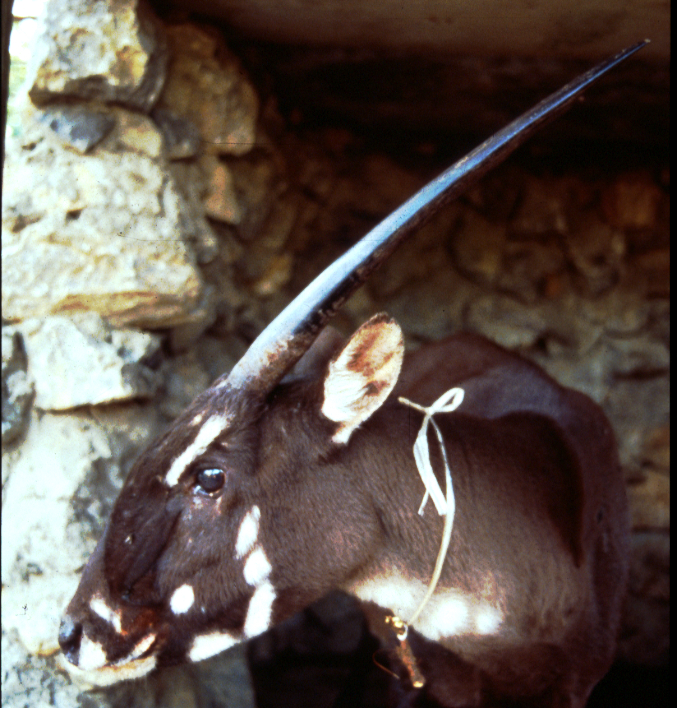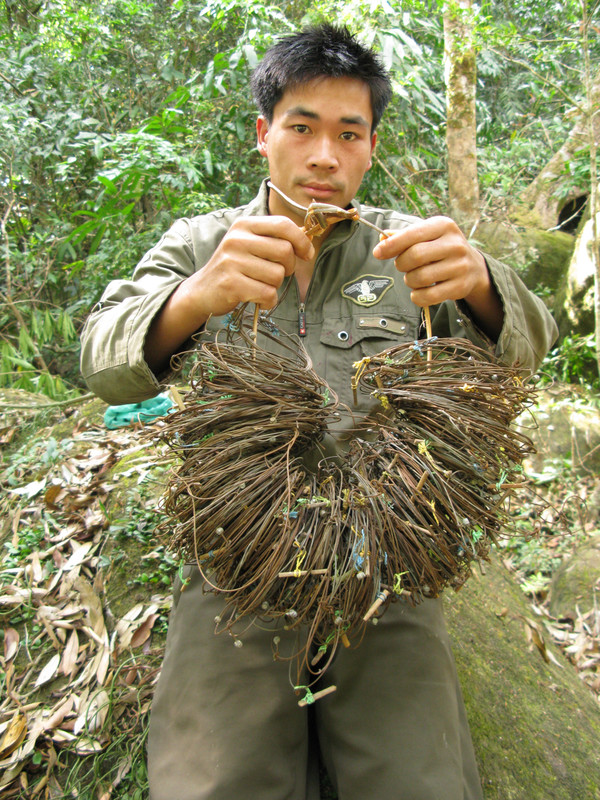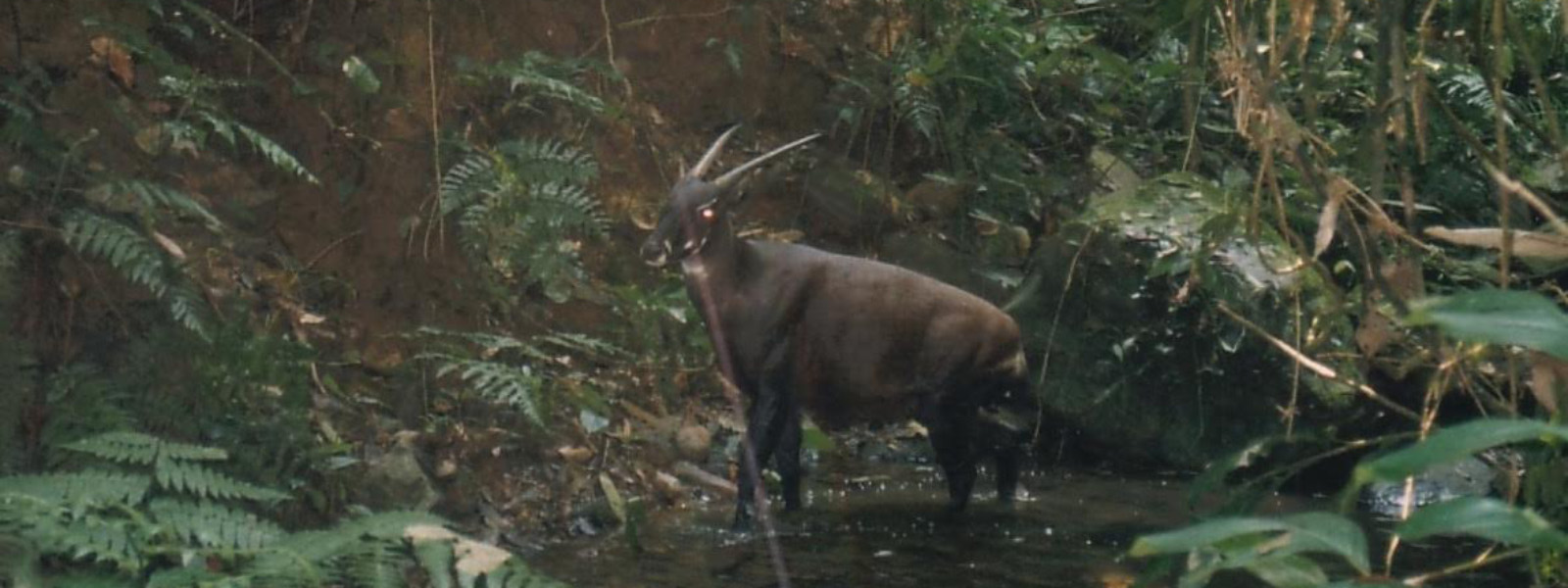The fight against Saola extinction: there’s still time if we act now
The IUCN Species Survival Commission (SSC) has today released a position statement that shows we must act now unless we want to lose Saola forever. It is a call to action for one of the most imperiled mammals on the planet.
The beautiful species lives in the Annamite Mountains of Vietnam and Lao PDR. Much of what is known about the elusive creature comes from local people, a handful of camera trap photos and the few individuals ever held in captivity (all only briefly). Because of the difficulty in detecting the animal, scientists have not been able to make a precise population estimate. Listed as Critically Endangered, the fact that Saola has not had a proven detection since 2013 suggests that it is now very rare.
Saola, Pseudoryx nghetinhensis, a 200 pound (90 kilogram) mammal, was unknown to science until 1992. A team of scientists discovered a skull with unusual horns in the home of a hunter in a remote village in Vietnam. It was the first new large mammal to science in more than 50 years, and an incredibly important discovery. To date, Saola has never been seen in the wild by a biologist.

Now, the SSC has made it clear they believe Saola continues to exist in the wild and more must be done to save it from extinction. The position statement brings to light the scale of potential Saola habitat that is yet to be properly searched for the species. It calls for a joint effort to find and conserve any remaining Saola before it is too late.
“We urgently need to coordinate unprecedented levels of detection efforts, foster an open collaboration and bridge the gap between science and conservation if we are to save Saola from extinction,” says Carolina Soto-Navarro, Viet Nam National Coordinator for the IUCN SSC Saola Working Group, an active network of members and implementing partners committed to saving Saola.
The biggest threat to the species is from illegal hunting. Saola can become caught in snares that have been set in the forest, even in the most remote areas, to target other, more sought-after animals like Sambar or civets. But snares are indiscriminate, injuring and killing any medium and large mammals that are unlucky enough to step on them.

The iconic Annamites species is the focus of a number of conservation projects.
WWF Vietnam has adopted a holistic approach that consists of identifying levers of change critical to save Saola from the brink of extinction. These range from protected area law enforcement, prioritisation of detection efforts using both local indigenous knowledge and state-of-the-art modern science such as eDNA, to nation-wide awareness campaigns, and corporate engagement. They also champion rewilding efforts in the country with national and international partners through the development of the first in-situ breeding centre for Saola and other endemic and highly endangered Annamite species.
“We are proud to be the leading organisation in Viet Nam driving and prioritising Saola conservation efforts in the country through our collaboration with the IUCN Saola Working Group,” says Thinh Van Ngoc, CEO WWF-Vietnam. “Our main efforts focus on enhancing collaboration and strengthening the in-country network of national stakeholders involved in Saola conservation. We do this through open communication and co-development approaches, leveraging and securing funding for conservation activities across the Saola range, and ensuring a strong and sound scientific-base to our practice.”
There is also active conservation work happening in Lao PDR. The Wildlife Conservation Society – Lao PDR Program supports Saola efforts as part of their vision for thriving and valued ecosystems. They work to improve protection and management of biodiversity by building the capacity of government and local stakeholders, community engagement and combating illegal wildlife trade.
“WCS has long been involved in Saola conservation through collaborations with the Saola Working Group and currently with the Saola Foundation. We see the importance of immediate and intensive searches for this iconic species of the Annamites as a fundamental step in our efforts to conserving Saola,” says Akchousanh Rasphone, PhD, Conservation and Science Director for Wildlife Conservation Society – Lao PDR Program.

Today’s position statement shows that a significant ramping up of search efforts is needed if the Saola is to be saved from extinction. It is estimated that only 30% of potential Saola habitat has been surveyed in any form for wildlife. Of this, as little as 2% has been intensively surveyed for Saola specifically. This goes a long way to explaining why a rare animal like Saola has not been officially recorded in the wild for a number of years. However, a hunter’s Saola trophy discovered in 2016 hints at its presence in at least one forest area of Vietnam within the last decade.
There is still time to save Saola, but that simply cannot happen without urgent investment in extensive and intensive search efforts.
“This is an opportunity to save a species from extinction. Saving Saola is a resource problem, not a technical one,” says Lorraine Scotson, CEO of the Saola Foundation, an organisation set up to help save Saola in the wild, and to conserve other threatened wildlife in the forests of the Annamite Mountains. “We understand the scale of the problem, and what it will take to find and to save Saola. Our challenge is to raise the funds we need in order to mobilise the search intensity called for by the SSC Position Statement. For this, we need the world to help!”.
Now, the SSC is urging immediate action to identify and conserve existing populations of Saola before it is too late.
“I encourage all international donors to the Saola conservation cause and our implementing partners in Vietnam and Lao PDR to contribute urgently to increasing the detection effort for Saola,” says James Burton, Chair of IUCN SSC Asian Wild Cattle Specialist Group (parent body of IUCN SSC Saola Working Group).
Nerissa Chao, Director of the IUCN SSC Asian Species Action Partnership says, “It is clear that search efforts must be significantly ramped up in scale and intensity if we are to save this species from extinction. For this to happen, there needs to be sustained financial investment in targeted locations.”
Key links:
- IUCN SSC Position Statement on the Conservation of Saola
- Saola Foundation: Let’s seize this moment!
- Saola Working Group statement

